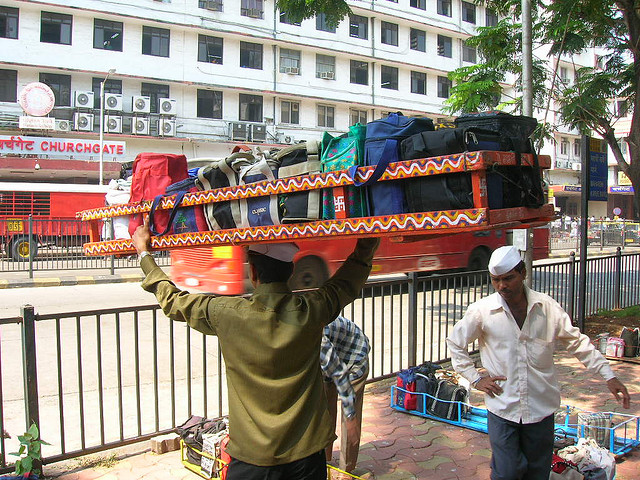
Few nations are as difficult to understand as India, home to dozens of languages, hundreds of tribes, and billions of people. One writer who has tried to make sense of the place is Patrick French, author of India: A Portrait, an ambitious book that draws on years of reporting and observation. French visited Zócalo on October 6th to discuss whether India, subject of so many narratives, is really rich or poor.
India is endlessly complicated – but it works. Somehow. More than a billion people manage to function, and make a nation, in a comparatively small area of land. I was never quite sure how this really happened, but the best example I know of India’s spontaneous, instinctive self-organization is the work of the dabbawallas of Mumbai.

They are the white-capped men who push handcarts stacked with metal tiffin carriers, containing people’s lunch. Some business analysts believe the dabbawallas offer a new model of management, others that they follow the five-forces theory or have six-sigma performance. They are part of a complex network, the product of a self-regulated business that operates in one of the world’s densest urban environments.
Each day, the Nutan Mumbai Tiffin Box Suppliers Association delivers 200,000 cylindrical dabbas, or stacked containers of food, from homes to offices using only bicycles, local trains and handcarts, with each box marked with a series of colored numbers and letters. The dabbawallas follow two slogans, “War Against Time” and “Work is Worship,” and start and complete their mission between the hours of 9 a.m. and 12.30 p.m. each day. Their managers claim an error rate of 1 in 16 million.
Each working day, a dabbawalla will wheel his bicycle to about three dozen houses in a particular neighborhood and collect a dabba from each one, hook it to the frame of the bike and go to a local railway station. There-joined by the other dabbawallas-he will slot the containers of food into large, painted wooden crates at high speed, almost as if he were doing it by intuition. When the train draws into the station, each man has a heavy wooden crate balanced on his head. A riot of pushing begins as they try to get all the crates aboard.
At one of the big stations near the centre of Mumbai, hundreds of dabbawallas converge from different trains and stack big, carefully balanced handcarts with about 120 tiffin boxes each, the process working smoothly as the codes on each box are matched with the delivery routes. The codes are designed for people who cannot read. The number painted at the centre of the dabba’s lid indicates the destination station; the mark at 12 o’clock is the originating suburb; at three o’clock is an abbreviation of the delivery address; at six o’clock is the owner’s name; at nine o’clock are coded letters showing the home delivery route for the return of the dabba. Within this, innumerable variations are permitted. Some of the boxes are painted with special codes because they are destined for a large office. Others use an additional form of marking, the numbers and letters painted in certain colours. When the handcarts are stacked, they are pushed by a brigade of dabbawallas in their white caps. It is a convention that they are allowed to cross through traffic, a privilege not given to other pushcarts.
Although Mumbai has plenty of fast-food stalls, most cooking reflects India’s national flexibility. In Western countries, a good, regular meal might consist of two ingredients, like steak and chips (beef and potatoes) perhaps with salt, mustard and ketchup. In India, a simple vegetarian lunch will contain more ingredients. So, packed into a standard three- or four-storey tiffin box there might be: cooked white rice; pigeon peas tempered with ground cumin seeds, turmeric, ginger, garlic, salt, red chilli, dried mango powder and oil; small aubergines stuffed with green chilli, turmeric, jaggery, onion, mustard seeds, dried coconut, coriander leaves, asafetida, cloves, cinnamon sticks, peppercorns, tamarind and salt; spinach and tomatoes with ginger, garlic, ground coriander and cumin, salt, fenugreek, chilli powder, oil and garam masala – itself a mixture of ground bay leaves, cloves, cumin, cinnamon, coriander, cardamom, star anise, nutmeg and white pepper; yoghurt with mint, sugar, pomegranate and black salt; cucumber relish; a type of bread, touched with clarified butter and stuffed or layered with spiced mashed potato; a few fresh green chillies; a wedge of lime and two types of pickle – and a good pickle can have fifty ingredients.
The dabbawallas’ venture started in 1890, when Parsis-Zoroastrians-who were travelling to work on the new railway system found they could not get their own food at lunchtime. As new mills and businesses opened, other social groups took the chance to have meals delivered, since there was a caste suspicion of food cooked outside the home. The system worked in Mumbai, because the trains were so crowded that you needed people to carry food on your behalf, outside the rush hour. Although the prohibition on restaurants has largely disappeared now, it is still cheaper to bring your own food from home, and the dabbawallas’ service remains popular.
“At first they used coloured threads, the offcuts from tailoring shops, to mark the tiffin,” Gangaram Talekar, the head of the dabbawallas, told me when I visited him. “Today we use a number and letter code, although never the number 9.” This was not because it was inauspicious, but because it might be muddled with the Marathi “6,” which looks a bit like a “9” with a tail. “We have never had a strike in 120 years, and there are no team leaders, no seniors and juniors. We have never had a police case against a dabbawalla. When bombs were hidden in tiffin tins in other cities in 2002, we told the police we would take responsibility, we would take care of it in Mumbai. We keep full control over our tiffins. We are all descended from the warriors of [the 17th century local king] Chhatrapati Shivaji Maharaj. We are the Varkaris.”
Almost all the dabbawallas come from the same sub-caste, and can even trace their origins to villages-Akola, Ambegaon, Junnar-in a region outside Pune. They come from a very close social group, and started the delivery system as a way to make a living. Their ability to run a complex, intuitive distribution system arises from their homogeneity, which is not unconnected to their regional and religious chauvinism.
“Our customers come from all communities: Christians, Muslims. But we couldn’t have a Muslim or someone from Bihar [in the north of India] doing this work. We prefer not to have others joining the dabbawallas because we have complete trust within our community. We know each person, and the trust would be broken.”
Gangaram Talekar was adamant that the dabbawallas’ system was linked to their social culture, and more specifically to the particular Hindu religious traditions that they followed in their part of Maharashtra, which dated back over centuries. “Our grandparents lived in the mountain ranges, which gave them strength. They were following the Varkari movement, and were known for being polite and for singing hymns. We take our beliefs from our travelling gurus, who have taught us. Our gurus told us to go beyond the mind. We follow and admire the teachings of Sant Tukaram every day: ‘Duty First,’ ‘Work is Worship,’ ‘Serving Food is Serving God,’ ‘Unity is Strength.’ If you are a member of our community, you must do your own duty.”
This essay is adapted from a chapter in Patrick French’s India: A Portrait.
Buy the book: Skylight, Amazon, Powell’s
*Photo courtesy of evidences.




Send A Letter To the Editors